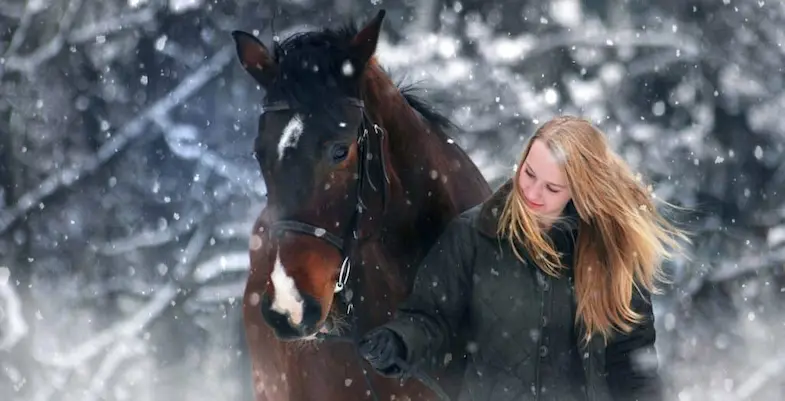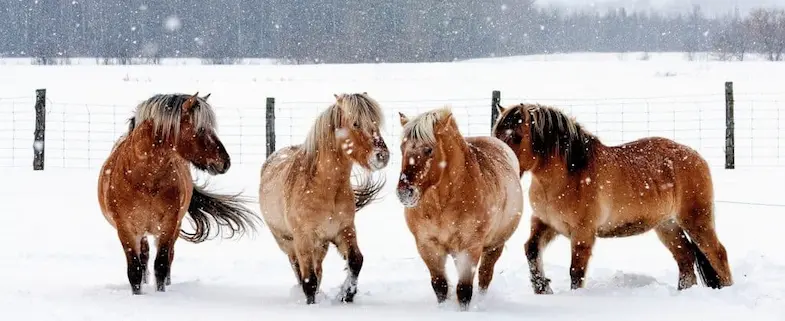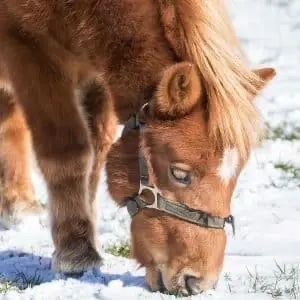When the weather starts to get colder we all have our own ways of dealing with it and keeping warm but what’s the best way of helping our horses deal with the cold and stay warm? Every horse will cope with the cold differently and some breeds, depending on their native habit, will be able to deal with it better. While some horses will have a better coping mechanism than others there are certain steps that will need to be taken when it comes to keeping them warm. As a basic ‘checklist’ the following will need to be considered.
- Clipping – If you’re able to leave your horse’s coat to naturally grow during the winter this will help to keep them warm.
- Blanket – A lot of horses will need blankets during the winter so make sure they’re all in a good condition beforehand and if necessary repair or replace them.
- Shelter – Make sure that all of the shelters don’t need mending, they should be able to give your horse proper protection from the wind and rain.
- Food – Your horse won’t be able to get to the grass as easily as he can in the summer so make sure you increase his forage intake during the winter to make up for this.
- Water – While horses will eat snow it’s important to make sure they still have enough freshwater. Eating snow will drop their body temperature and make it harder for them to stay warm.
- Check teeth – Check your horse’s mouth and teeth to make sure he’s not going to have any problems chewing his food.
- Hooves – If you live in an area that gets a lot of snow you might want to ask your farrier to fit anti-snowball pads or snow rim pads. These will prevent snow and ice from building up on the underside of the hooves.
Do horses get cold in winter?
Just like all other mammals horses will suffer from the cold during the winter but the good news is that they’re able to deal with the cold far better than we can. Even the most delicate of breeds and those that are more adapted to hotter climates are pretty hardy and can cope with much colder temperatures than you might think.
That doesn’t mean to say that no matter how cold the weather is you can turn your horse out and expect him to be fend for himself. You’ll still need to make sure he has plenty of fresh food and water and that he’s warm enough. You may have to rug him up to depending on the thickness of his coat and whether or not he’s clipped.
How do I know if my horse is cold?
You can quickly check if your horse is cold by feeling his ears or putting your hand under his rug but neither of these methods should be relied on. If your hands are cold then his ears or under his rug will feel warmer than they are and vice versa if your hands are warm. While you can use these methods to gauge if he’s cold or not it’s better to back it up with other observations and checks.
- Is your horse constantly moving? If your horse has started to run around his pasture much more than normal and there’s no obvious sign of distress then he could be doing this to keep warm.
- Is your horse a hard keeper? Hard keepers find it harder than good keepers to stay warm during the winter. This is because they have a lower amount of fat to keep them warm and end up burning the calories they consume to keep warm rather than using those calories to increase their body weight. If your horse is a hard keeper then this article I wrote on feeding a hard keeper on a budget may help you.
- Is a group of horses gathered together? While it’s not always the case that they’re cold horse do often huddle together to keep warm and dry. If your horse is cuddling up to the other horses more than usual it could be because he’s cold.
- Is your horse shivering? While this might seem like an obvious sign of being cold it can often be overlooked. If your horse has been in a warm stable overnight he may well shiver when you first turn him out, this is normal but what’s more important is he still shivering a long time after?
The most reliable way of telling if your horse is cold though is to check his vital signs. Checking these will not only tell you his temperature (and therefore whether he’s cold or not) but will also indicate if there’s something else wrong too. If you’re not sure how to check your horse’s vital signs or what they should be then you might want to have a read of this recent article I wrote about vital signs.
Can a horse freeze to death?
Horses are able to deal with the cold much better than us but they can still suffer from hypothermia which, if not dealt with, can become fatal so the obvious answer is yes they can absolutely freeze to death. Sadly there have been way too many cruelty cases that have proven this if we were in any doubt.
That said if you make sure your horse has enough food and water as well as a sturdy shelter and you check on him at least once or twice a day then this isn’t going to happen, even if your horse spends all day lying in the snow or on frozen ground. The danger comes when they have no protection from the elements and no food to help keep them warm.
How do you take care of a horse in the winter?
It’s important to start to prepare for the winter before it arrives, make sure you’ve got enough food, especially hay. You also need to check all of the water pipes to make sure they’re working and there are no leaks. Before the weather gets really is cold it’s important to check the shelters to make sure they’re in good condition and that they will give your horse enough protection from the wind and rain.
There are a few simple steps that you can take to make sure your horse is warm and safe during the winter.
- Make sure your horse has plenty of water – The increased quantity of foods such as hay will mean that your horse will naturally want to drink more water to make up for the lack of water in his food. If the weather gets too cold you might want to think about heating it up a little too.
- Feed him more hay – Make sure you’ve got plenty of hay to see your horse through the winter. You’ll need to increase the amount of hay he eats to help keep him warm but also to make up for the reduction in natural forage.
- Check your horse’s rugs – Check any winter rugs over to make sure there’s no tears or rips in them. It’s also a good idea to make sure they still fit your horse before you need to use them.
- Have your horse’s feet checked – Just because it’s cold it doesn’t mean your horse’s hooves won’t grow so they need to be checked too. If you tend to get a lot of snow then you might want to fit anti-snowball pads to the shoes to stop snow building up on the underside of the hooves.
- Check your horse’s teeth – Make sure your horse doesn’t have any problems with his teeth that could prevent him from being able to eat properly. Like hooves, your horse’s teeth should be checked all year round but during the winter it is even more important.
- Check fencing and shelters – You might not think you need to check the fencing but if any of it needs to be replaced it’ll be much easier to do this while it’s dry and not so cold. Also, check any trees or plants that grow over the fencing and shelter and cut them back if necessary.
How does a horse stay warm in the winter?
In the wild horses keep themselves warm by, amongst other things, growing a thick, waterproof winter coat. This helps to keep them insulated, dry, and nice and warm. They will also put on extra weight before the winter which enables them to use their fat reserves when there isn’t as much food around. Horses also instinctively know how to shelter from the elements so they will look for shelter when it’s raining and will seek thick shrubbery or heavy tree cover to protect themselves from the wind.
This is why we need to provide them with shelter especially in a pasture with little or no tree cover. If you clip your horse’s coat during the winter then you’ll also need to replace his coat with a rug or blanket regardless of whether they stabled or turned out. Otherwise, they’ll be unable to stay warm.
Should I clip my horse in winter?
There’s no quick answer to this question as there are many reasons why people clip their horses during the winter. For example, does your horse spend a lot of time outside, what is his workload like, does he suffer from Cushing’s. All of these will play a part in whether or not you clip your horse as will your personal preference. If you want to know more about clipping your horse you might want to read this article.
If you do clip your horse though you will need to use a rug and or blanket during the winter.
Should I blanket my horse in winter?
The jury is still out on whether or not you need to rug your horse up during the winter. Some people will argue that in the wild their natural coats will help to keep them warm while others will state that a rug will protect them from the elements. When it does come to rugging your horse though there are a number of factors that will help to answer the question. For example, if you clip your horse for any reason at all then you will need to use a rug.
If you are going to use a rug or blanket during the winter but aren’t sure what type of rug you need then you may find this guide to blankets that I wrote helpful.
Do horses need more hay when it’s cold?
Absolutely yes! As with all other creatures horses need extra calories during the colder winter months in order to help keep themselves warm. This is because they work harder in the winter to keep their body temperature at the right level and with this, they need more calories than they would during the summer. Increasing their calories will mean that they will be able to burn those calories rather than turning to burn their own fat which would result in a loss of body weight. More calories, however, doesn’t just mean more food period – you need to be feeding the right type of food which is why we increase the amount of hay.
During the winter, especially if there’s a frost or snow, natural forage is harder to get to and of poorer quality compared to during the summer. This is another reason why you need to increase your horse’s hay intake, in order to replace this lack of natural forage.
How much hay does a horse need per day in the winter?
When it comes to how much hay your horse needs during the winter it will depend to some extent on his age, condition, weight, and workload. You also need to take into account the ambient temperature but as a general rule, you should double their hay intake.
As a guide the table below should give you a rough idea as to how much hay your horse should have per day during the summer and during the winter:
| Horse’s weight in Kg (approximate hands) | Summer hay (Kg) | Winter hay (Kg) |
| 200 (8) | 4 | 8 |
| 300 (11) | 6 | 12 |
| 400 (14) | 8 | 16 |
| 500 (15) | 10 | 20 |
| 600 (16) | 12 | 24 |
| 700 (17) | 14 | 28 |
| 800 (18) | 16 | 32 |
Conclusion
With a little be of preparation your horse will be so snug and warm that he won’t even know that the ground is covered with snow!
I hope you found this article helpful. If you did I’d be grateful if you could share it please as it would really help me.
Recommended products
Over the years I have tried hundreds of different horsey products, from various blankets and halters to different treats. Some I’ve loved, others I’ve hated but I thought I’d share with you my top all-time favorite products, the ones I never leave the yard without. I’ve included links to the products (which are in no particular order) that I really think are great.
- Horse Knots by Reference Ready – If you’re like me and enjoy pocket reference guides then you’ll love this knot tying guide. These handy cards can easily fit in your pocket or attach to the saddle for quick reference. They’re waterproof, durable and are color coded to make them easy to follow.
- Mane ’n Tail Detangler – Even if you never show your horse you’ll need to detangle his tail from time to time (and possibly his mane too) which is always a challenging chore! I’ve found that if I run a little bit of detangler through my horse’s tails every few days it stops them from getting matted up and makes combing them easy, even if they’re coated in mud. I don’t know if I should admit to this or not but it also works wonders on my hair.
- TAKEKIT Pro clippers – Over the years I’ve tried a lot of different clippers and while some were obviously better than others I found these to be by far the best. They are heavier than a lot of other clippers but for me, that’s a good thing, it makes them feel more sturdy and hardwearing. On top of that they have a range of speeds so are just as good for clipping your horse’s back as they are his face. I also like the fact that they come in a handy carry case but that’s not for everybody. The company that makes them is super good and incredibly helpful too, a real bonus these days. The only thing I wasn’t keen on was the fact that it doesn’t come with any oil, but that’s not a major problem as it’s not difficult to buy lubricant.
- Shire’s ball feeder – There are so many boredom buster toys out there but I like to use these every day, regardless of whether or not my horses are bored. I find that it helps to encourage my horses to problem solve by rewarding them with treats (or pieces of fruit) but it also mimics their natural grazing behavior which helps to keep them calm and de-stressed.
- Horse safe mirror – This is a strange one that many people are surprised about but I like to put horse safe mirrors in the trailers as well as in the quarantine stalls. It helps to prevent the feeling of isolation by giving the impression of other horses being around. Being herd animals horses can get extremely stressed when they feel that they’re on their own but with these stick-on mirrors, they believe that at least one other horse is with them.
- Rectal thermometer – I know this isn’t glamourous at all but it’s vital for your horse’s well-being to be able to check their temperature and a rectal thermometer is the easiest way of doing this which is why I’ve added it to the list.
Shopping lists
I’ve also put together a few shopping lists of essential items that I’ve found helpful over the years. I’ve broken the lists down into different categories rather than put everything in one massive list 😉



